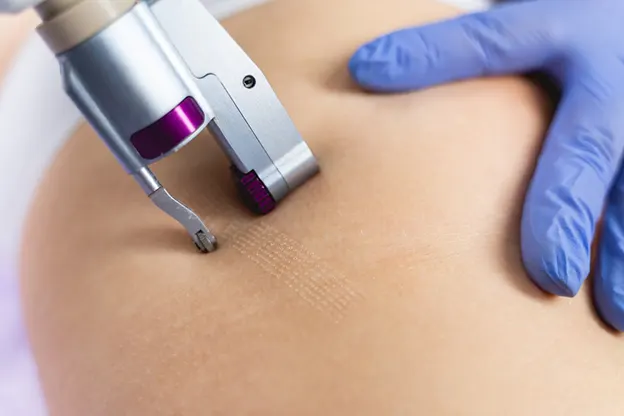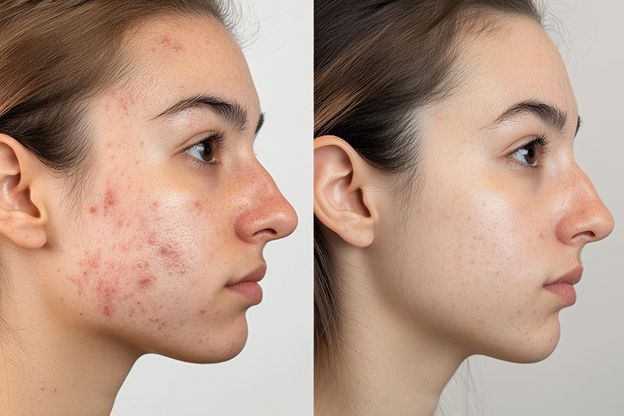Laser Dermatology
How Lasers Can Improve Your Skin
Skin Troubles That Laser Therapy Can Fix
Laser procedures can effectively manage numerous cosmetic and medical skin problems. Among the most common are the following:
- Skin surface imperfections: Laser skin rejuvenation improves sun damage signs, fine wrinkles, and superficial scars.
- Pigmentation issues: Laser treatment takes away melasma, sun spots, hyperpigmentation, some birthmarks, and unwanted tattoos.
- Connective tissue conditions: The procedure corrects sagging skin, deep wrinkles, stretch marks, and acne scarring.
- Blood vessel abnormalities: Laser technology removes spider veins, broken capillaries from rosacea, and some raised birthmarks.
- Unwanted hair: Laser treatment helps reduce unwanted or excessive hair seen in hormonal imbalance (hirsutism), generalised hair growth (hypertrichosis), and shaving-related irritation (ingrown hairs).
- Inflammatory disorders: Lasers also work on acne, skin thickening from rosacea, and some forms of psoriasis.
Laser light therapy may be performed alone or as part of a broader treatment plan for better outcomes. For example, it can complement skin needling to fade deep scars, dermal fillers to improve skin texture, and chemical peels to correct sun-induced skin ageing.

Laser Skin Resurfacing for Tattoo Removal
Lasers and Other Light-Based Skin Treatments
Lasers and similar light-based therapies come in various types. That’s because no single approach works for every skin type or problem. At our Chester and Liverpool clinics, we offer a wide range of light-based therapies, each designed to target specific skin issues. Dr Thiru will guide you in deciding which option is most suitable for you.
Ablative Lasers
Ablative lasers are designed so their light is particularly absorbed by the top skin layers. These lasers gently cut and peel off the outermost portions of the treated area, revealing fresher skin underneath—a technique called “resurfacing.” As the site heals, collagen production increases, and remodelling of underlying tissues helps tighten the skin for a smoother, firmer appearance.
The CO2 laser is the typical choice for most patients, although both CO2 and erbium types are available. Ablative laser skin resurfacing can address many skin problems, including sun damage, melasma, acne scars, visible blood vessels, excess hair, and the effects of rosacea. The procedure is highly effective, though the skin reactions it can produce mean people with darker skin tones require careful monitoring to avoid unwanted pigmentation issues or scarring.

CO2 Laser Treatment for Mole Removal
Non-Ablative Lasers
Rather than creating a shallow wound on the surface, non-ablative lasers work through intact skin, gently heating the deeper skin structures to activate repair cells and boost collagen production. Since there’s no open wound, inflammation is minimal and downtime is short, but visible results take longer to appear. Several types of non-ablative lasers are available, but two of the most trusted are pulsed-dye (PDL) and picosecond lasers.
PDL produces yellow light, which is naturally absorbed by blood vessels. It can also be used for gentle skin resurfacing and removing warts and deeper scars. Picosecond technology is often chosen for laser tattoo removal, delivering quick energy bursts that fragment stubborn ink efficiently.
Fractional Lasers
Fractional technology reduces inflammation from lasers. Rather than covering the entire treated surface, fractional lasers work on hundreds of tiny points, leaving small gaps of healthy skin to speed healing. The skin repairs itself from these untouched zones, so recovery is quicker and feels easier. Fractional laser therapy can treat a vast spectrum of skin concerns, including skin tone and texture issues, unwanted pigmentation, burn scars, and sagging.

Fractional Laser Surgery for Stretch Marks
Intense Pulsed Light
Intense pulsed light (IPL) is often grouped with lasers but isn’t actually one. Lasers emit a single concentrated colour of light that delivers energy precisely where needed. In contrast, IPL releases multiple colours in bursts, spreading energy more evenly across the skin. The result is a gentler treatment that can cover larger areas effectively.
IPL improves skin tone and texture and targets unwanted pigment, such as age spots. The same technology may also be applied for long-term hair removal.
Radiofrequency Therapy
Radiofrequency (RF) energy comes from radio waves, which comprise a kind of energy related to light but work differently. Rather than relying on colours, RF treatment uses gentle electrical energy and heat to address skin issues. The technique promotes skin tightening and removes minor growths, such as skin tags and moles, with little discomfort.

Unwanted Pigmentation Treatment with Intense Pulsed Light

Acne Scars Before and After Fractional Laser Treatment

Uneven Pigmentation and Skin Tone Before and After Laser Skin Resurfacing
Laser Dermatology: Frequently Asked Questions
Here are some frequently asked questions about laser dermatology in Liverpool:

